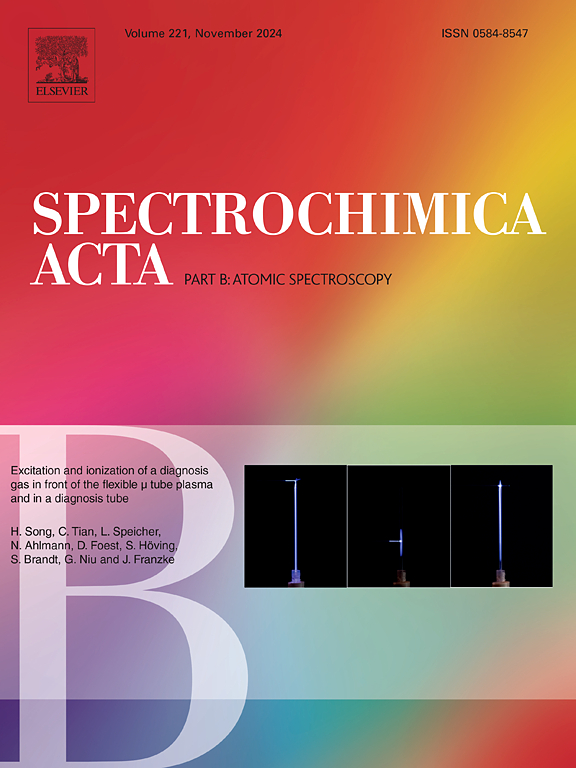Double Pulse laser-induced breakdown spectroscopy (DP-LIBS): A Comprehensive technique Review
IF 3.2
2区 化学
Q1 SPECTROSCOPY
引用次数: 0
Abstract
Double pulse-laser induced breakdown spectroscopy (DP-LIBS) is one of the most widely adopted variants of laser-induced breakdown spectroscopy for rapid elemental analysis. DP-LIBS is an effective way of improving the emission line intensities and increasing the analytical capabilities of conventional LIBS. We comprehensively overviewed different aspects of DP-LIBS from fundaments to applications. The key mechanisms of pre-ablation, reheating, and interpulse delay have been discussed. Different geometrical configurations for the two pulses including collinear, cross-beam, orthogonal pre-ablation, and orthogonal reheating are outlined. The pulse durations of the ablating laser have a huge impact on the ablation process, thus, the effects of the temporal settings of the laser pulse duration are explained. This includes ns-ns, fs-fs, fs-ns, and long short DP-LIBS. The impacts of double-pulse LIBS on the ablation process and analytical outcomes such as signal intensity, repeatability, ablation rate, crater and plasma size, and plasma parameters are encapsulated. Finally, several DP-LIBS applications from metal and alloy analysis and explosive detection to industrial analysis have been stipulated. DP-LIBS approach results in a notable enhancement in the emission intensity; however, repeatability is a key parameter to consider for meaningful applications. Among different temporal configurations, long-short DP-LIBS provides relatively smoother and greater interaction of the laser beam with the plasma plume and sample, hence giving a more temporally efficient energy delivery to the plasma and sample making it more suitable for intensity enhancement and signal improvement among other variants.

双脉冲激光诱导击穿光谱技术综述
双脉冲激光诱导击穿光谱(DP-LIBS)是激光诱导击穿光谱中应用最广泛的快速元素分析方法之一。DP-LIBS是提高常规LIBS发射谱线强度和提高分析能力的有效途径。我们全面概述了DP-LIBS从基础到应用的不同方面。讨论了预烧蚀、再加热和脉冲间延迟的关键机理。概述了共线脉冲、横束脉冲、正交预烧蚀脉冲和正交再加热脉冲的不同几何结构。烧蚀激光的脉冲持续时间对烧蚀过程有很大的影响,因此,解释了激光脉冲持续时间设置的影响。这包括ns-ns、fs-fs、fs-ns和长-短DP-LIBS。研究了双脉冲LIBS对烧蚀过程和分析结果的影响,如信号强度、可重复性、烧蚀速率、火山口和等离子体尺寸以及等离子体参数。最后,介绍了从金属和合金分析、炸药检测到工业分析的几种DP-LIBS应用。DP-LIBS方法显著增强了发射强度;然而,对于有意义的应用程序,可重复性是一个需要考虑的关键参数。在不同的时间配置中,长-短DP-LIBS提供了相对平滑和更大的激光束与等离子体羽流和样品的相互作用,从而为等离子体和样品提供了更有效的时间能量传递,使其更适合于强度增强和信号改善。
本文章由计算机程序翻译,如有差异,请以英文原文为准。
求助全文
约1分钟内获得全文
求助全文
来源期刊
CiteScore
6.10
自引率
12.10%
发文量
173
审稿时长
81 days
期刊介绍:
Spectrochimica Acta Part B: Atomic Spectroscopy, is intended for the rapid publication of both original work and reviews in the following fields:
Atomic Emission (AES), Atomic Absorption (AAS) and Atomic Fluorescence (AFS) spectroscopy;
Mass Spectrometry (MS) for inorganic analysis covering Spark Source (SS-MS), Inductively Coupled Plasma (ICP-MS), Glow Discharge (GD-MS), and Secondary Ion Mass Spectrometry (SIMS).
Laser induced atomic spectroscopy for inorganic analysis, including non-linear optical laser spectroscopy, covering Laser Enhanced Ionization (LEI), Laser Induced Fluorescence (LIF), Resonance Ionization Spectroscopy (RIS) and Resonance Ionization Mass Spectrometry (RIMS); Laser Induced Breakdown Spectroscopy (LIBS); Cavity Ringdown Spectroscopy (CRDS), Laser Ablation Inductively Coupled Plasma Atomic Emission Spectroscopy (LA-ICP-AES) and Laser Ablation Inductively Coupled Plasma Mass Spectrometry (LA-ICP-MS).
X-ray spectrometry, X-ray Optics and Microanalysis, including X-ray fluorescence spectrometry (XRF) and related techniques, in particular Total-reflection X-ray Fluorescence Spectrometry (TXRF), and Synchrotron Radiation-excited Total reflection XRF (SR-TXRF).
Manuscripts dealing with (i) fundamentals, (ii) methodology development, (iii)instrumentation, and (iv) applications, can be submitted for publication.

 求助内容:
求助内容: 应助结果提醒方式:
应助结果提醒方式:


